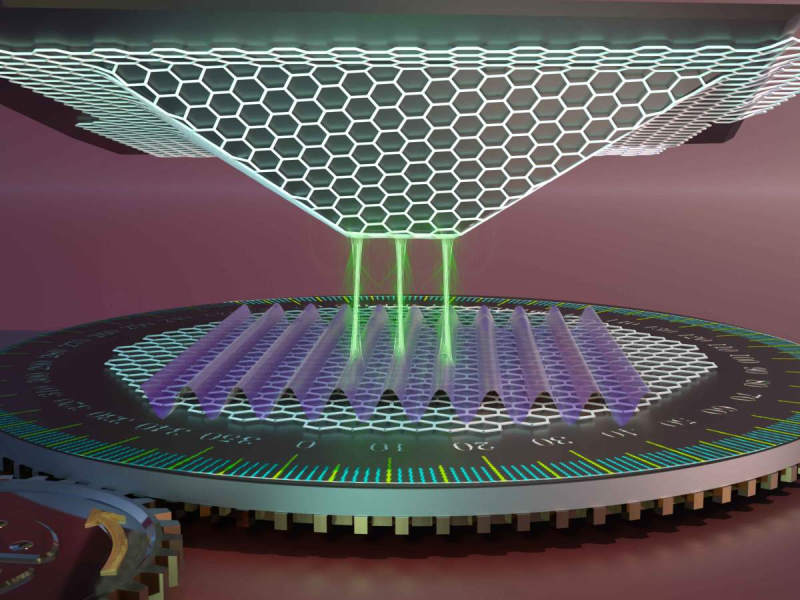Putting the Twist into Quantum Imaging
Stacking two layers of graphene on top of each other—and adding a slight “twist” between them—produces a material that exhibits a range of remarkable electronic phenomena, from the unrestricted flow of superconductors to the impeded transport of strange metals. Physicists can explore this rich electronic landscape just by altering the relative orientation between the two sheets of this so-called twisted bilayer graphene (TBG), creating a whole new field of study called twistronics.
Such intriguing behavior, first observed in 2018, is thought to derive from a strong coupling between electrons and phonons—the quantized vibrational motions of a crystal lattice. But efforts to understand this interaction have been hampered by the lack of experimental tools for directly probing the phonons in TBG. Now an international team of researchers has shown theoretically how a novel type of microscope could offer a way to study the electron–phonon coupling in TBG and other twisted 2D lattices—known collectively as moiré systems [1]. Such investigations could help unravel the origin of superconductivity in TBG while also informing the development of novel devices such as superconducting switches (see Trend: Bilayer Graphene’s Wicked, Twisted Road).
The focus of this theoretical analysis is an instrument called a quantum twisting microscope (QTM), which was first demonstrated in 2023 by a team led by Shalal Ilani from the Weizmann Institute of Science in Israel [2]. Unlike other imaging tools that detect electrons as particles at a single location, the QTM makes it possible to probe the wave-like behavior of electrons, which emerges from their quantum ability to seemingly be in multiple locations at the same time.
The customized instrument is based on an atomic force microscope, but in this case the sharp tip is replaced with a pyramidal probe that has a flat surface at its apex. This probe is overlain with a single layer of a 2D material such as graphene, while the sample is either the same or another 2D material mounted onto a flat substrate. When the surface of the probe comes into contact with the sample, it creates a flat interface across which an electron can tunnel along many different paths. “By providing an electron with multiple routes to cross into the sample—but without us knowing where it actually crossed—we allow the electron to preserve its fragile wave-like nature,” explains Ilani. And, like other waves, the electron can produce interference effects.
The result of this interference in the QTM is that tunneling only happens when the electron wave functions in the probe and sample have the same momenta. This requirement is met by specific electron states that depend on the angle between the crystal structures of the two materials, which can be altered in the QTM by rotating the probe. In their experiments the researchers can continuously vary the twist angle—as well as the bias voltage applied between the probe and sample—while recording the changes in the tunneling current. These measurements allow the energies of the electron states to be mapped as a function of their momenta, producing the band structure that is one of the key quantum properties of materials.
Initial experiments at room temperature have shown that the QTM can be used to visualize the electron energy bands within both monolayer graphene and TBG, and even to study the gradual flattening of a low-energy band in TBG when large local pressures are applied. In the new work [1], a team of theorists led by Felix van Oppen from the Free University of Berlin has worked with Ilani to explore how a QTM operating at cryogenic temperatures can be used to study the coupling between electrons and phonons in TBG and other moiré systems.
The idea in this case is to keep the bias voltage below the threshold at which electrons can directly tunnel from the probe to the sample. In this regime, tunneling can only happen if an extra kick of momentum is supplied through the release of a phonon. These phonons are associated with various vibrational modes that exist both within and across the sheets of the bilayer system, each of which has a characteristic energy. This proposed technique would reveal the spectrum of phonon energies, while the theoretical framework presented by the researchers offers a way to disentangle the different processes that contribute to the phonon spectrum. Their analysis suggests that it should be possible to quantify the strength of the electron–phonon coupling for each phonon mode, something that has proved particularly challenging for other characterization techniques.
“This is vital information to understand the role of phonons in the physics of moiré systems like twisted bilayer graphene,” comments Hector Ochoa, a theorist at Columbia University who was not involved in the work. He says that the theoretical models developed in this work will be valuable not only for extracting useful numbers from QTM measurements but also for framing the way that physicists should think about phonons in twisted 2D lattices.
Preliminary experiments reported by the team have shown that a cryogenic QTM can be used to probe specific electron–phonon coupling mechanisms in TBG [3]. These early findings already offer an insight into coupling processes that are relevant to the superconducting and strange-metal behavior of TBG, and they suggest that other moiré systems might be investigated in the future with these new experimental and theoretical techniques.
–Susan Curtis
Susan Curtis is a freelance science writer based in Bristol, UK.
References
- J. Xiao et al., “Theory of phonon spectroscopy with the quantum twisting microscope,” Phys. Rev. B 110, 205407 (2024).
- A. Inbar et al., “The quantum twisting microscope,” Nature 614, 682 (2023).
- J. Birkbeck et al., “Measuring phonon dispersion and electron-phason coupling in twisted bilayer graphene with a cryogenic quantum twisting microscope,” arXiv:2407.13404.





